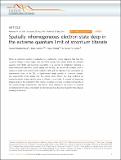| dc.contributor.author | Bhattacharya, Anand | |
| dc.contributor.author | Khalsa, Guru | |
| dc.contributor.author | Suslov, Alexey V. | |
| dc.contributor.author | Skinner, Brian J | |
| dc.date.accessioned | 2017-04-14T14:22:29Z | |
| dc.date.available | 2017-04-14T14:22:29Z | |
| dc.date.issued | 2016-09 | |
| dc.date.submitted | 2016-06 | |
| dc.identifier.issn | 2041-1723 | |
| dc.identifier.uri | http://hdl.handle.net/1721.1/108163 | |
| dc.description.abstract | When an electronic system is subjected to a sufficiently strong magnetic field that the cyclotron energy is much larger than the Fermi energy, the system enters the extreme quantum limit (EQL) and becomes susceptible to a number of instabilities. Bringing a three-dimensional electronic system deeply into the EQL can be difficult however, since it requires a small Fermi energy, large magnetic field, and low disorder. Here we present an experimental study of the EQL in lightly-doped single crystals of strontium titanate. Our experiments probe deeply into the regime where theory has long predicted an interaction-driven charge density wave or Wigner crystal state. A number of interesting features arise in the transport in this regime, including a striking re-entrant nonlinearity in the current–voltage characteristics. We discuss these features in the context of possible correlated electron states, and present an alternative picture based on magnetic-field induced puddling of electrons. | en_US |
| dc.description.sponsorship | United States. Department of Energy (DE-AC02-06CH11357) | en_US |
| dc.description.sponsorship | United States. Department of Energy (DE-AC02-06CH11357) | en_US |
| dc.description.sponsorship | United States. Department of Energy (DE-SC0001088) | en_US |
| dc.description.sponsorship | National Science Foundation (U.S.) (DMR-1157490) | en_US |
| dc.language.iso | en_US | |
| dc.publisher | Nature Publishing Group | en_US |
| dc.relation.isversionof | http://dx.doi.org/10.1038/ncomms12974 | en_US |
| dc.rights | Creative Commons Attribution 4.0 International License | en_US |
| dc.rights.uri | http://creativecommons.org/licenses/by/4.0/ | en_US |
| dc.source | Nature | en_US |
| dc.title | Spatially inhomogeneous electron state deep in the extreme quantum limit of strontium titanate | en_US |
| dc.type | Article | en_US |
| dc.identifier.citation | Bhattacharya, Anand; Skinner, Brian; Khalsa, Guru and Suslov, Alexey V. “Spatially Inhomogeneous Electron State Deep in the Extreme Quantum Limit of Strontium Titanate.” Nature Communications 7 (September 29, 2016): 12974. | en_US |
| dc.contributor.department | Massachusetts Institute of Technology. Department of Physics | |
| dc.contributor.mitauthor | Skinner, Brian J | |
| dc.relation.journal | Nature Communications | en_US |
| dc.eprint.version | Final published version | en_US |
| dc.type.uri | http://purl.org/eprint/type/JournalArticle | en_US |
| eprint.status | http://purl.org/eprint/status/PeerReviewed | en_US |
| dspace.orderedauthors | Bhattacharya, Anand; Skinner, Brian; Khalsa, Guru; Suslov, Alexey V. | en_US |
| dspace.embargo.terms | N | en_US |
| dc.identifier.orcid | https://orcid.org/0000-0003-0774-3563 | |
| mit.license | PUBLISHER_CC | en_US |
| mit.metadata.status | Complete | |
